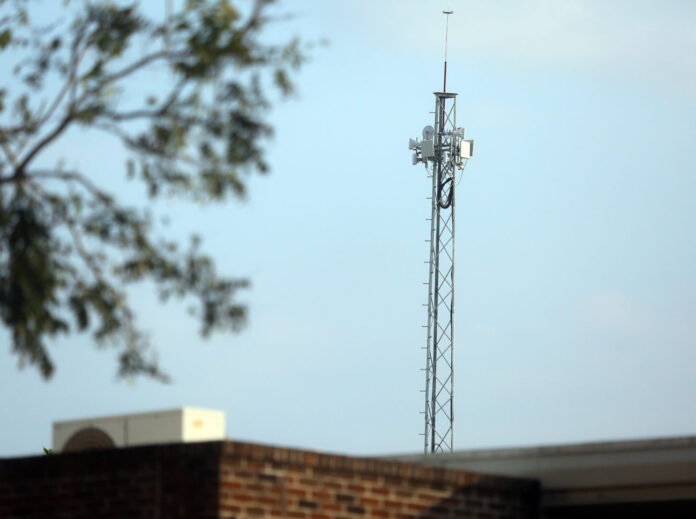
|
Only have a minute? Listen instead
Getting your Trinity Audio player ready...
|
DONNA — The administration and staff at Donna ISD faced a sobering statistic early on in the pandemic: a survey conducted on district parents in June indicated over half of the district’s students lacked access to the internet.
Those students had limped through the end of the 2019-20 school year, but as it became apparent that the pandemic would stretch into the next semester, the district’s administration began searching for a long-term solution to its connectivity problem.
The district ultimately landed on erecting a dozen communications towers, meant to beam wireless internet access to students out in a 1-mile radius.
Although the project has faced setbacks since the district signed a contract for the towers in late August, the end is finally in sight. Just prior to Thanksgiving break four of the towers were erected and ready to be turned on. A fifth was scheduled to be ready to activate a few days later.
Crews started erecting three more towers on Nov. 25, pouring concrete and pointing the hundreds of feet of metal straight into the air.
Superintendent Hafedh Azaiez expects those towers will be a solution to an immediate problem (pandemic inspired remote learning) but he also expects them to fix a problem Donna ISD has faced for much longer: the digital divide.
“This is how students in the 21st century should be learning,” he said. “Online and face-to-face, it’s called a blended learning model. So that’s what we want to be, even after this COVID-19 era is gone, we want to continue giving access to our students.”
Azaiez says when the pandemic forced students at the district to learn virtually in March, the district had few hotspots and lacked enough devices for every student.
They’ve since acquired enough devices to provide every student with one, but hot spots continued to be a problem. Although they acquired many hotspots as well, they found the connectivity they provided to be lacking.
“What we found out is that some of the hot spots did not work,” Azaiez said. “Not necessarily because they did not have data, it’s just because there are certain areas in Donna that are rural and so the companies, like Spectrum or Verizon or whatever, did not have antennas nearby, so there was no signal.”
Students who still couldn’t connect lacked real-time connection with their instructors, he said, and while teachers tried connecting via phone or other means, students in the district who can’t connect for synchronous instruction are left struggling through their coursework mostly solo.
“So the students are pretty much left on their own trying to figure out how to do their work,” Azaiez said.
Students who decided not to return to campus and lack connectivity at home were still in that situation as of this month, Azaiez says. He says even families that have Wi-Fi are struggling in other ways.
“I can tell you, a lot of our parents are probably struggling to pay for that internet, because it’s expensive,” he said.
The district expects those 12 towers to remedy those problems and provide Wi-Fi access to somewhere between 8,000 and 10,000 kids, about two-thirds of Donna ISD’s enrollment. When they’re complete and complemented by hot spot coverage, Azaiez expects everyone of the roughly 7,000 students in his district to have internet access.
The district is investing a hefty chunk of change to make that happen. The tower project is expected to cost about $3.7 million, and Azaiez says it will take between $150,000 and $180,000 a year to maintain them and acquire a signal — a cost they’ve tried to mitigate by placing the towers on property already owned by the district near existing electricity and internet infrastructure.
Azaiez says although the tower project will cost the district more money upfront, hot spots would be prohibitively expensive as a long-term fix, costing the district as much as $2 million a year.
“From a cost standpoint, in the long-run it would cost us a lot of money,” he said. “It [the towers] will be a lot cheaper down the road, if we want to keep that benefit to our students beyond the COVID era.”
Although the project has been a priority for the district, it’s faced weeks-long setbacks. Originally slated to be completed in early November, it now appears like all of the towers may not be fully operational until sometime in December.
Pandemic-related material delays contributed to that setback, Azaiez said, along with problems erecting the towers.
“The water table is very high here in Donna, especially north Donna. So they were having some issues getting the foundation done right, the concrete and everything to stabilize,” he said. “So that kind of slowed everything down.”
Still, the superintendent remains optimistic.
“Considering that we’re not in the business of putting up towers, we’re doing OK,” he said.
Azaiez also remains optimistic about the long-term success of the project and what it’ll do for students at Donna ISD.
In many ways, he says giving those kids access to the internet gives them educational opportunities that are long overdue.
“Me personally, I don’t see internet connection as a privilege or a luxury,” Azaiez said. “Internet connection should be like water and electricity. We’re leveling the playing field, we’re eliminating the digital divide by giving our students access to the internet, so they can learn and research and study, and they can continue progressing academically even when they’re at home.”




